THE RED COAT APPLE OF FRANKLIN CO. VA
A GOOD CIDER APPLE
IS IT JEFFERSON'S LOST TALIAFERRO APPLE?
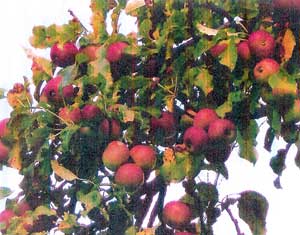
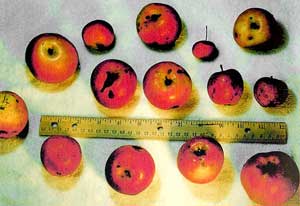
Dr Francis Amos of Rocky Mount, Franklin Co, Virginia, remembers the pleasant cider made, in
his youth, from the Red Coat apple which was grown everywhere in eastern Franklin County,
including in the yard of his grandmother's farmhouse, but which has since largely disappeared.
Around about the year 2004, he began a quest to find a living Red Coat apple tree from which
grafts could be made to perpetuate the variety. Above left is a Red Coat apple tree loaded with
ripe apples and above right is a sampling of ripe apples together with a one-foot ruler, for
scale.
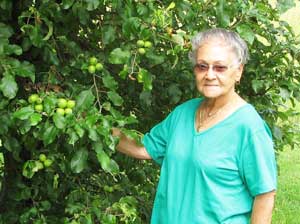
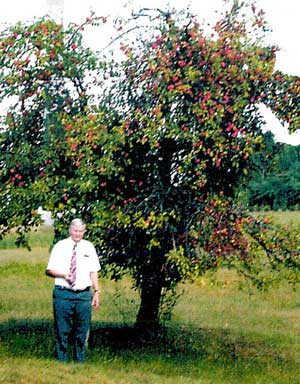
Dr Amos had some difficulty finding a Red Coat tree, but, when Nannie Stanley heard about his
quest, she told him that she thought she remembered a Red Coat apple that her father, the late
Will Tyree, had planted at an old farmhouse some 70 years earlier. When Mrs Stanley and Dr
Amos visited the farmhouse, they found what must be one of the few remaining old Red Coat
apple trees. Above left is Nannie Stanley recently at her father's tree and above right is Dr Amos
at the tree when full of ripe apples
 Dr Amos was acquainted with Clyde Jenkins of Stanley, Page Co. Virginia, a basketmaking
craftsman who also grafts and sells old apple varieties. Mr Jenkins appears regularly at a crafts
festival at Ferrum College in Franklin County. Dr Amos cut off a small branch of what we will
call the Mother Tree and gave it to Mr Jenkins, asking him to try to graft more Red Coat apple
trees. Mr Jenkins obtained the necessary scionwood from parts of the branch and made a number
of successful grafts. To the left is a picture of apple grafter Clyde Jenkins.
Dr Amos was acquainted with Clyde Jenkins of Stanley, Page Co. Virginia, a basketmaking
craftsman who also grafts and sells old apple varieties. Mr Jenkins appears regularly at a crafts
festival at Ferrum College in Franklin County. Dr Amos cut off a small branch of what we will
call the Mother Tree and gave it to Mr Jenkins, asking him to try to graft more Red Coat apple
trees. Mr Jenkins obtained the necessary scionwood from parts of the branch and made a number
of successful grafts. To the left is a picture of apple grafter Clyde Jenkins.
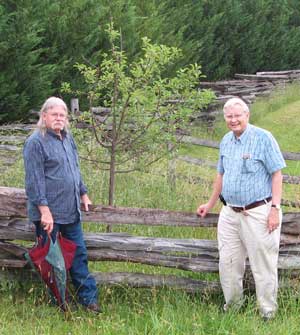 Two of these grafted trees ended up close to the home of Dr Amos, but the third was planted at
the Blue Ridge Institute and Museum, a part of Ferrum College, where it thrives today behind a
split rail fence as an example of the apple culture that used to be much more widespread across
Franklin County. Pictured with the Ferrum tree are Roddy Moore, Director of the Blue Ridge
Institute and Museum and Dr Francis Amos, a rediscoverer of the Red Coat apple.
Two of these grafted trees ended up close to the home of Dr Amos, but the third was planted at
the Blue Ridge Institute and Museum, a part of Ferrum College, where it thrives today behind a
split rail fence as an example of the apple culture that used to be much more widespread across
Franklin County. Pictured with the Ferrum tree are Roddy Moore, Director of the Blue Ridge
Institute and Museum and Dr Francis Amos, a rediscoverer of the Red Coat apple.
Because of certain similarities between the Red Coat and the Taliaferro (pronounced Toliver)
apples, Dr Amos and others were led to suspect that the two might be identical. For those not
familiar with this apple, it might help to point out that the Taliaferro is the closest thing going to
the holy grail of missing apples. It was Thomas Jefferson's favorite cider apple, and he
considered its cider to be the closest beverage to champagne that he knew of that was not
produced from grapes. He gave out graftable scionwood and even the occasional grafted trees to
any of his family or friends who wanted them.
So what do we know about the Taliaferro apple? Descriptions conflict, with none of them being
totally reliable.
The next two letters were published in Memoirs of the Philadelphia Society for Promoting
Agriculture, Vol 4, 1818, pages 49-51
In a 29 June 1814 letter to Dr James Mease, Thomas Jefferson wrote
"[The Taliaferro apple] is not a crab, but a seedling which grew alone in a large old field near
Williamsburg, where the seed had probably been dropt by some bird. Major Taliaferro of that
neighbourhood remarking it once to be very full of apples, got permission of the owner of the
ground to gather them. From this he made a cask of cyder which, in the estimation of every one
who tasted it, was the finest they had ever seen. He grafted an orchard from it, as did also his
son-in-law our late chancellor Wythe. The cider constantly made from this, was preferred by
every person to the crab or any cyder ever known in this state, and it still retains its character in
the different places to which it has been transferred. 1 am familiar with it, and have no hesitation
in pronouncing it much superior to the Hugh's crab. It has more body, is less acid, and comes
nearer to the silky Champaign than any other. Major Taliaferro called it the Robertson apple from
the name of the person owning the parent tree, but subsequently it has more justly and generally
been distinguished by the name of the Taliaferro apple, after him to whom we are indebted for
the discovery of its valuable properties. It is the most juicy apple I have ever known, and is very
refreshing as an eating apple."
William Coxe, author of the 1817 book entitled Cultivation of Fruit Trees wrote a letter
on 21 May 1814 to the same Dr James Mease, quoting from his book which apparently had not
yet been published and from a letter from Jefferson which was apparently yet to be written. The
letter read:
"The Gloucester White, Taliaferro, or Robertson Apple.
"A White thin skin, with many small red spots on the stem end; very juicy, of a keen aromatic
taste. The fruit hangs till late in September, ripen quick, and fall, as soon as ripe, the tree at the
same time drops its leaves. Its size is about that of a large red-streak. An immense bearer, a very
fine cider apple, and by many, thought the finest table apple of the season, in Virginia. The
branches are stubbed. Mr. Jefferson described it as much superior to the Hugh's crab for cyder, as
that is to any other fruit.
"Dear Sir,
"The above description of the "Gloucester white" is extracted from my book. I have supposed it
of Virginia origin, that is, first cultivated there, but cannot vouch for the fact.
"Very sincerely and respectfully yours,
"William Coxe."
One might wonder what apple Coxe was describing as the Gloucester White, Taliaferro, or
Robertson Apple. Taliaferro and Robertson were the same apple, but the Gloucester White was a
different apple. When Coxe published his book, A View of the Cultivation of Fruit Trees,
etc. in 1817, on page 114 he wrote :
"NO. 23. GLOUCESTER WHITE.
"This apple is of a middling size; of a shape not very uniform, varying from an oblong to a flat
form; the colour when ripe, is a bright yellow, with clouds of black spots: the flesh is yellow,
rich, breaking, and juicy; of a fine flavour as a table apple, and producing cider of an exquisite
taste. The stalk is of the ordinary length, inserted in a cavity of medium depth, the crown is
moderately deep: the time of ripening is about the first of October, after which the fruit soon falls
and is fit for cider. It does not keep long, but while in season, is a delicious table apple, the tree is
very thrifty, hardy and vigorous; of a regular and beautiful form, and very productive. It is much
cultivated in the lower counties of Virginia, from whence I procured it, as an apple of high
reputation."
[N.B. This shows that three years after his 1814 version, Mr Cox did not consider the Gloucester
White to be the same as the Taliaferro. Furthermore, his Gloucester White is said to be bright
yellow with black spots, while the earlier account of Gloucester White alias Taliaferro said that it
was white skinned with many little red spots around the stem end. It seems very possible that the
earlier account was of the characteristics of the Taliaferro, not the Gloucester White.]
Since Coxe described the Taliaferro as about the size of a large Redstreak, his description in the
1817 volume of the Redstreak on page 157 becomes relevant.
"NO 95. REDSTREAK
"This tree was originally brought from England, where it possessed a high reputation as a cider
fruit; it has been cultivated extensively in this country, by the descendants of the English settlers
in New York, New Jersey, and Pennsylvania. The climate of America is supposed to have
revived the character of this apple, which had deteriorated in its native soil, from the long
duration of the variety -- the fruit is rather small; the form is oblong, flattened at both ends, the
stem and crown both sunk -- the skin is red, faintly streaked and spotted with yellow -- the flesh
is yellow, rich, firm, and dry; it hangs late, and requires to be matured by housing to make the
finest cider. The character of the cider, when properly made and fined, is very high, both for
strength and flavour -- the apple keeps well through the winter, and is much esteemed as an
excellent kitchen fruit in the latter part of winter. The tree is of handsome, regular growth, and a
great bearer: the opinion of dealers is, that this cider is difficult to fine fit for bottling: when
perfectly cleared, it ranks among our first fruit liquors."
------
The New American Orchardist, William Kendrick , Boston, 1835
page 75, reads:
"CELEBRATED CIDER APPLES CULTIVATED IN THE UNITED STATES.
. . .
"TALIAFERO. Hon. J. C. Gray. [Elsewhere called John C. Gray of Boston]
"The fruit is the size of a grape shot, or from one to two inches in diameter; of a white color,
streaked with red ; with a sprightly acid, not good for the table, but apparently a very valuable
cider fruit. This is understood to be a Virginia fruit, and the apple from which Mr Jefferson's
favorite cider was made."
-----
The Fruits and Fruit Trees of America, A.J. Downing and Charles Downing, New York,
1890 page 192, reads:
"Gloucester White.
"Origin, Gloucester Co., Va. Tree vigorous and very productive. Fruit medium, roundish oblate,
fine yellow. Flesh yellow, juicy, crisp, pleasant, subacid. Good. October,
November."
-----
Peter J. Hatch of Monticello states that Boston pomologist William Kenrick provided the only
published description of the Taliaferro in 1835. In making this statement he appears to ignore the
1814 statement by William Coxe describing the Gloucester White, Taliaferro, or Robertson
Apple in Dr James Mease's account read to the Philadelphia Society for Promoting Agriculture.
It is true that William Coxe was confusing the Gloucester White apple with the Taliaferro apple,
and that by the time he published his book in 1817, he omitted all reference to the Taliaferro
apple in his description of the Gloucester White apple. But it is important to note that in 1817,
he described the Gloucester White as being a yellow-skinned middling-size apple with clouds of
black spots on the skin, while in 1814, he described an apple with white thin skin, with many
small red spots on the stem end, the apple being the size of a large red-streak apple (which he
described in 1817 as having rather small fruit). Although he was clearly confused, he was not
describing the Gloucester White apple in his 1814 description. It seems highly probable that he
was describing the Taliaferro apple in 1814. Coxe had sent Mease to Jefferson for details of the
Taliaferro apple.
If Coxe was actually describing the Taliaferro apple in 1814, then we have quite a bit of
information to use in identifying it.
1. The tree must have a middling size fruit
2. The fruit must have thin white skin with many small red spots on the stem end.
3. The fruit must be extremely juicy (the juiciest Jefferson has ever known)
4. The fruit must have a keen aromatic taste
5. The fruit must ripen quickly in late September
6. The fruit must fall quickly as soon as it is ripe.
7. The leaves must fall immediately when the fruit does (rare for a September apple?).
8. The fruit must make good (or excellent) cider.
9. The tree should bear lots of fruit.
10. The branches must be stubbed (perhaps fruit spurs?)
11. According to Jefferson, the fruit must be good for eating out of hand.
It seems probable that Coxe, in 1814, rather than being mistaken for assuming that "Taliaferro"
was another name for the Gloucester White apple that he was describing, was mistaken for
assuming that "Gloucester White" was another name for the Taliaferro apple that he was
describing. He later had an entirely different description for the Gloucester White.
Is Red Coat another name for Taliaferro? There are eleven points listed above. Some are still
being tested, We know from recollections by Dr Amos that the apple makes good cider when
mixed with other apples, which is the only way it was done in his youth, Effort is being made to
get enough Red Coat apples to make a testable amount of pure Red Coat cider. It is only a matter
of time before this test is complete. Mr Jenkins has indicated that the tree drops its apples and its
leaves in late September. It must be an extremely rare characteristic for any apple tree to drop all
of its leaves suddenly in September. The skin of the Red Coat apple is usually red with some
green areas, particularly around the blossom end of the fruit. This does not match the described
color of the Taliaferro apple. Coxe said that the apple had thin white skin with many small red
spots on the stem end. Kendrick said the fruit was of a white color, streaked with red. Thus
there is one strong point (early dropping of leaves) in favor of the two trees being the same and
one strong point (color difference) in favor of the two trees being different varieties. It is
noteworthy that neither of the two men who described its color had apparently ever seen it. Also
Jefferson described his apple as being very refreshing to eat and Kendrick said the same apple
was not good for the table. Was he even describing Jefferson's apple?
If it is assumed that Red Coat is another name for Taliaferro, and that is far from certain, how
could it have become locally widespread around eastern Franklin Co VA? Two possibilities
have been recognized.
First:
Robert Taliaferro emigrated to Virginia in the mid-1600s and established the extensive Taliaferro
family in America. The name is usually pronounced "Tolliver." He married Sarah Grymes and
had a large family, including sons John and Francis. John was later Col. John Taliaferro and
married Sarah Smith. Their large family included a son Richard Taliaferro (1706-1748), who
married Rose Anne Berryman. Francis Taliaferro married Eliza (or Elizabeth) Catlett -- their
family included another Richard Taliaferro. The second Richard was Major (later Colonel)
Richard Taliaferro who lived from 1705 through 1779. The two Richards were first cousins and
grandsons of the emigrant.
Major Richard Taliaferro had a daughter Elizabeth Taliaferro who married George Wythe, the
eminent Virginian who, among other things, was Thomas Jefferson's law professor at William
and Mary. According to Jefferson, Major Taliaferro was the man who discovered the Taliaferro
apple growing as an accidental seedling in a field owned by a Mr. Robinson. He took cuttings,
propagated the tree, and made it famous. At the time, many people grew it, including George
Wythe.
The Richard Taliaferro who died in 1748 was said to have drowned while taking a barge across
the Potomac River in Virginia. Rose Anne, his wife, was largely responsible for raising the
children. He owned a large tract of land in Amherst Co VA. His son Charles Taliaferro Sr
(1735-1798) married Isabella McCulloch and moved to Amherst Co. Charles was an officer in
the Revolutionary army.
Charles Sr and Isabella had a son Charles Taliaferro Jr (1761-1824). Charles Jr married Lucy
Loving. They had a son Richard McCulloch Taliaferro (1789-1861).
Richard M. Taliaferro was a physician and was said to have gone to a medical school in
Philadelphia (which would have been the only medical school in the country at the time.) When
he graduated, he moved to Rocky Mount, Franklin Co VA and set up a medical practice there.
He married Mary "Polly" Hale, who was apparently a daughter of the first family he met in
Franklin Co. In later life he was also a Justice of the Peace and a lawyer. They had six sons and
five daughters. The site of Dr Taliaferro's home is now the location of the hospital in Franklin
Co.
It is possible that Dr Taliaferro brought the family apple with him to Rocky Mount and it spread
from him. There is absolutely no known documentation or tradition to support this.
Second:
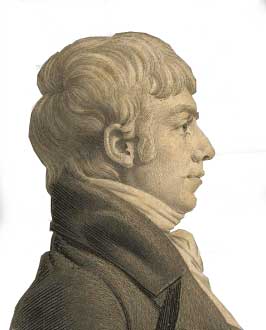 William Armisted Burwell was a family friend of Thomas Jefferson and was his personal
secretary from 1804 to 1806 during his Presidential years. To the left is his portrait from his
White House days. He later became a member of Congress. Burwell lived in what is now called
the Burwell-Holland house near Glade Hill, Franklin Co VA. According to the present
occupants of the house, Jefferson visited there several times, probably from Poplar Forest 45
miles away. It is possible that Jefferson gave Burwell scionwood to start his treasured Taliaferro
tree. It is noteworthy that the Red Coat apple was only known to occur within about ten miles of
Glade Hill. Again, there is absolutely no known documentation or tradition to support a Burwell
connection. In fact, there is no known documentation to support that Jefferson ever visited
Burwell at Glade Hill, but that is not essential, since Jefferson could have given Burwell cuttings
in Washington DC.
William Armisted Burwell was a family friend of Thomas Jefferson and was his personal
secretary from 1804 to 1806 during his Presidential years. To the left is his portrait from his
White House days. He later became a member of Congress. Burwell lived in what is now called
the Burwell-Holland house near Glade Hill, Franklin Co VA. According to the present
occupants of the house, Jefferson visited there several times, probably from Poplar Forest 45
miles away. It is possible that Jefferson gave Burwell scionwood to start his treasured Taliaferro
tree. It is noteworthy that the Red Coat apple was only known to occur within about ten miles of
Glade Hill. Again, there is absolutely no known documentation or tradition to support a Burwell
connection. In fact, there is no known documentation to support that Jefferson ever visited
Burwell at Glade Hill, but that is not essential, since Jefferson could have given Burwell cuttings
in Washington DC.
Tom Brown is a Seeker of Lost Apples living in Clemmons NC. His web site is applesearch.org In 2009 he found a Red Coat
apple and obtained graftable scionwood near Union Hall, Franklin Co VA. He offers grafted
trees for sale at twenty dollars each plus shipping (as of this writing). He describes his Red Coat
as "medium to large, slightly flattened, greenish-yellow with a red side, tart, ripe August, an
important local apple found in eastern Franklin Co VA." I was worried about the
discrepancy in description between the two versions of the Red Coat apple. I showed Mr Brown
the pictures of the Red Coat apple (reproduced above) as located by Dr Amos and asked if he
thought they were the same as his Red Coat apple. He wrote that the two apples were essentially
the same but that his apples might be slightly larger.
 There you have the facts as known to date. Decisions must be left to each reader, and will
probably come out divided. If the truth be told, we probably do not have quite enough yet for a
firm decision.
There you have the facts as known to date. Decisions must be left to each reader, and will
probably come out divided. If the truth be told, we probably do not have quite enough yet for a
firm decision.
I am told that Shaun Shepherd of Portland Oregon, a member of the Home Orchard Society who
wears two hats in that organization, as a cider apple specialist and as an identifier of unknown
apples, is awaiting a full opportunity to identify the Red Coat apple. More power to
him.
The Red Coat apple does not appear to be an extremely vigorous tree, so extremely dwarfing
rootstocks should not be used when grafting. The Mother Tree, which is probably about 70 years
old, is about 14 feet tall and produces heavily even though it has not been properly pruned for
many years. If grafted onto a dwarfing rootstock, this tree probably would produce very few
apples. Considering when and where the Mother Tree was planted, it is probably grafted onto a
seedling rootstock, which is usually roughly equivalent to a standard rootstock for dwarfing
purposes. To the left is a recent picture of the Mother Tree, about 70 years old and maturng
another crop of apples
Click here to go to top page of MYOUTBOX.NET




 Dr Amos was acquainted with Clyde Jenkins of Stanley, Page Co. Virginia, a basketmaking
craftsman who also grafts and sells old apple varieties. Mr Jenkins appears regularly at a crafts
festival at Ferrum College in Franklin County. Dr Amos cut off a small branch of what we will
call the Mother Tree and gave it to Mr Jenkins, asking him to try to graft more Red Coat apple
trees. Mr Jenkins obtained the necessary scionwood from parts of the branch and made a number
of successful grafts. To the left is a picture of apple grafter Clyde Jenkins.
Dr Amos was acquainted with Clyde Jenkins of Stanley, Page Co. Virginia, a basketmaking
craftsman who also grafts and sells old apple varieties. Mr Jenkins appears regularly at a crafts
festival at Ferrum College in Franklin County. Dr Amos cut off a small branch of what we will
call the Mother Tree and gave it to Mr Jenkins, asking him to try to graft more Red Coat apple
trees. Mr Jenkins obtained the necessary scionwood from parts of the branch and made a number
of successful grafts. To the left is a picture of apple grafter Clyde Jenkins. Two of these grafted trees ended up close to the home of Dr Amos, but the third was planted at
the Blue Ridge Institute and Museum, a part of Ferrum College, where it thrives today behind a
split rail fence as an example of the apple culture that used to be much more widespread across
Franklin County. Pictured with the Ferrum tree are Roddy Moore, Director of the Blue Ridge
Institute and Museum and Dr Francis Amos, a rediscoverer of the Red Coat apple.
Two of these grafted trees ended up close to the home of Dr Amos, but the third was planted at
the Blue Ridge Institute and Museum, a part of Ferrum College, where it thrives today behind a
split rail fence as an example of the apple culture that used to be much more widespread across
Franklin County. Pictured with the Ferrum tree are Roddy Moore, Director of the Blue Ridge
Institute and Museum and Dr Francis Amos, a rediscoverer of the Red Coat apple. William Armisted Burwell was a family friend of Thomas Jefferson and was his personal
secretary from 1804 to 1806 during his Presidential years. To the left is his portrait from his
White House days. He later became a member of Congress. Burwell lived in what is now called
the Burwell-Holland house near Glade Hill, Franklin Co VA. According to the present
occupants of the house, Jefferson visited there several times, probably from Poplar Forest 45
miles away. It is possible that Jefferson gave Burwell scionwood to start his treasured Taliaferro
tree. It is noteworthy that the Red Coat apple was only known to occur within about ten miles of
Glade Hill. Again, there is absolutely no known documentation or tradition to support a Burwell
connection. In fact, there is no known documentation to support that Jefferson ever visited
Burwell at Glade Hill, but that is not essential, since Jefferson could have given Burwell cuttings
in Washington DC.
William Armisted Burwell was a family friend of Thomas Jefferson and was his personal
secretary from 1804 to 1806 during his Presidential years. To the left is his portrait from his
White House days. He later became a member of Congress. Burwell lived in what is now called
the Burwell-Holland house near Glade Hill, Franklin Co VA. According to the present
occupants of the house, Jefferson visited there several times, probably from Poplar Forest 45
miles away. It is possible that Jefferson gave Burwell scionwood to start his treasured Taliaferro
tree. It is noteworthy that the Red Coat apple was only known to occur within about ten miles of
Glade Hill. Again, there is absolutely no known documentation or tradition to support a Burwell
connection. In fact, there is no known documentation to support that Jefferson ever visited
Burwell at Glade Hill, but that is not essential, since Jefferson could have given Burwell cuttings
in Washington DC. There you have the facts as known to date. Decisions must be left to each reader, and will
probably come out divided. If the truth be told, we probably do not have quite enough yet for a
firm decision.
There you have the facts as known to date. Decisions must be left to each reader, and will
probably come out divided. If the truth be told, we probably do not have quite enough yet for a
firm decision.